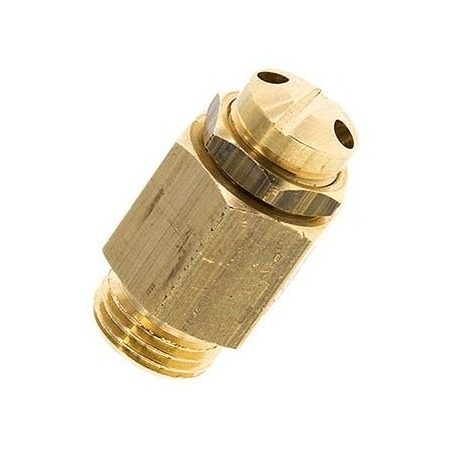
Safety relief valves protect systems when system pressure rises above the maximum allowable working pressure. At this point, safety valves open and quickly discharge the system’s media until system pressure drops within the safe boundary. Keep reading to learn which applications use safety valves and how they work.
Safety relief valve applications
Safety valves operate in industrial settings to control overpressure, which is any pressure above the safety relief valve’s set pressure. The following are typical applications for safety valves:
- Food, beverage, and pharmaceutical: Systems that demand the utmost protection against contamination use stainless steel safety valves.
- Power: Safety valves protect against the over pressurization of compressed air and gas in power plants.
- HVAC: Blocked discharge and thermal expansion can damage HVAC systems. Safety valves help prevent this.
- Petroleum: Subsurface safety valves quickly shut down a system if components malfunction or break. This quick action prevents further media flow to prevent dangerous explosions.
Safety relief valve types
The key feature of a safety valve is how its design allows it to open quickly. The top of the valve’s disc, which is its closing mechanism, has a lip isolated from flowing media until the disc opens. Therefore, the media immediately interacts with a higher surface area when the disc opens. This quickly increases the power acting on the disc, pushing it open to about 60% fully open.
There are several types of safety relief valves. Three of the most common are spring-supported single-action, pilot-operated, and balanced bellows.
Spring-supported safety relief valves
A spring-supported safety valve is applicable from 1 to 1400 bar. The spring holds the disc closed and controls the valve’s set pressure. The disc cracks and rapidly opens when the system media’s pressure overcomes the spring force. The spring is factory set and can be adjustable or non-adjustable. Spring-supported safety relief valves have the following components:
- Nozzle: Media flows into the nozzle from the inlet.
- Nozzle ring: The nozzle ring controls the valve’s reseating pressure. If set too low, the disc will vacillate and if set too high, the disc will reseat too late.
- Closing mechanism: The closing mechanism is typically a disc or a poppet.
- Expansion chamber: The disc rises into the expansion chamber, which has space for the disc’s wider top and also allows the media pressure to begin dropping quickly.
- Spring: As mentioned above, the spring controls the disc’s cracking pressure.
Pilot-operated safety valve
A pilot-operated safety valve is composed of two different valves: a pilot valve and a main valve. The pilot valve’s spring is adjustable or non-adjustable and controls the safety valve’s cracking pressure. The main valve’s spring is non-adjustable and relatively soft. The pilot hole allows media to go above and below the main valve when media flows into the valve. Therefore, the pressure above and below the main valve is equal, and the closing mechanism stays closed.
Media also flows to the pilot valve. When the media pressure rises enough to open the pilot valve, the media positioned above the main valve flows through the pilot valve and out of the relief valve’s outlet. This creates a pressure differential above the main valve, allowing the media below it to open. At this point, media can flow through the safety valve at normal flow rates.
Balanced bellows safety valve
A balanced bellows safety valve can be single-action or pilot-operated. The key difference is that metal bellows are above the main disc. These bellows are suitable for systems with a high degree of backpressure, pressure coming back into the valve’s outlet. Uncontrolled, this backpressure can damage the top of the disc. The bellows distribute the backpressure evenly across the top of the valve, so no specific zone receives too much pressure.
Selection criteria
When looking for a safety relief valve, consider the following criteria:
- Set pressure: If the system has a constant maximum allowable working pressure, a non-adjustable safety valve may be appropriate. Choose an adjustable safety valve if the maximum working pressure is likely to fluctuate.
- Backpressure: Is pressure likely to rise downstream of the safety valve’s discharge? If so, consider a balanced bellows safety valve.
- Discharge capacity: A safety valve must be able to discharge media rapidly. So, the safety valve’s discharge capacity must handle the system’s normal flow rates.
- Operating temperatures: Ensure the system’s media temperature will not negatively affect the safety valve’s material.
- Sealing material: Ensure the sealing material is suitable for the system’s media to reduce the chance of malfunction.
Safety relief valve certifications
Internationally recognized certifications ensure that products are safely manufactured and are the least likely to malfunction. The three top certifications for safety relief valves are TÜV, ASME, and ISO 4126.
- TÜV: TÜV verifies that products meet the requirements of Pressure Equipment Directive (PED) 2014/68/EU. The PED sets the standards for designing and manufacturing safety pressure valves, steam boilers, pipelines, and pressure vessels.
- ASME: ASME ensures the specification and accreditation of pressure vessels, boilers, and pressure relief valves.
- ISO 4126: ISO 4126 is a general specification for pressure vessels, no matter the application’s media.













